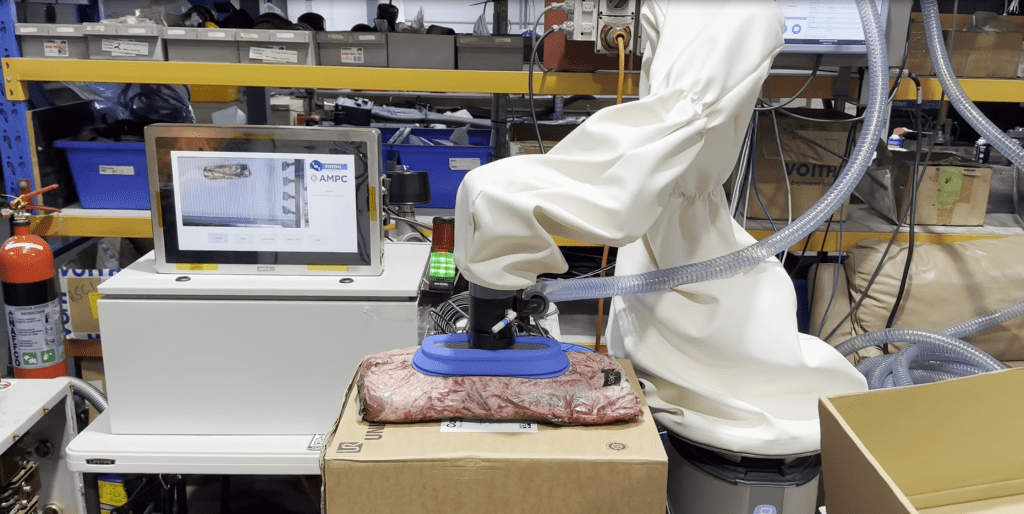
 This item is part of a series focusing on red meat R&D, presented by Beef Central and the Australian Meat Processor Corporation. These items highlight a range of projects designed to enhance the efficiency, productivity, product quality and safety of Australian red meat sold into the domestic market and around the world. All have the ability to help underpin Australia’s unrivalled reputation as the world’s premier export of quality beef, lamb and offal. Links to previous articles in the series appear below.
This item is part of a series focusing on red meat R&D, presented by Beef Central and the Australian Meat Processor Corporation. These items highlight a range of projects designed to enhance the efficiency, productivity, product quality and safety of Australian red meat sold into the domestic market and around the world. All have the ability to help underpin Australia’s unrivalled reputation as the world’s premier export of quality beef, lamb and offal. Links to previous articles in the series appear below.
COLLABORATIVE robots have been put into production trials at a New South Wales beef processing plant to evaluate the use of the technology to pick and pack vacuum-packed beef primals into cartons, in a high-throughput production environment.
The Australian Meat Processor Corporation is working with JBS Australia and technology provider, TME Systems on the project. The trials are taking place at JBS Australia’s Scone processing plant in NSW.
The collaborative robots project is part of a focus by AMPC to understand how the technology may be deployed within the Australian red meat processing industry, as part of a strategy to reduce manual handling and improve safety of employees.
Collaborative robots are intended for direct human-robot interaction within a shared space. They also minimise the need for traditional robot safety-guarding.
AMPC program manager Stuart Shaw said a significant part of the development included AI-enabled sensing systems interfaced with the robots which are used to identify the correct product. The development also includes product orientation which ensures correct placement within cartons.
“The benefit is improved accuracy,” Mr Shaw said.
JBS head of innovation and industrial engineering (Southern), Sean Starling said so far, the trials had shown great accuracy.
“JBS continues to look forward to working with TME Systems and AMPC to see how far this technology can be pushed. There are already high-level designs for how this single evaluation deployment could be integrated into the entire pick-and-pack area, with multiple vision and pick-and-pack cells working around current employees,” Mr Starling said.
“TME Systems has been accommodating and flexible in fitting in and working with the JBS facility.”
TME Systems robotics engineer Volker Brendel said AI advancements in the last couple of years had been a key factor to achieving the result. Identifying primal cuts would not have been possible previously, he said.
“Working with TME Systems, we will be looking at deploying additional robots within JBS and taking the development to the wider red meat processing industry,” AMPC’s Stuart Shaw said.
Previous articles in this series:
- New AI technology to support beef traceability
- Extracting kokumi – the new umami – from red meat
- Shadow robots reality a step closer + VIDEO
- One of Australia’s first AI-driven automated beef scribing systems installed
- AMPC’s inaugural Innovation Showcase program
- The trends that will drive innovation
- Australian first in hot boning technology
- What’s in the box? Technology driving label verification
- Red meat R&D: AMPC Academy of Meat Engineers designs own sausages
- ‘Spot the dog’ shows benefits of automated guided vehicle technology + VIDEO
- 3D printing trial begins at red meat processing plants
- Technology trial for small stock electronic ID
- Progress in shadow robotics
- Eating quality tool a step closer to commercial reality
- Advancing red meat sustainability
- 5G trial for Aussie red meat processing plants
- New product academy to see processors get the most out of each carcase
- Shadow robot technology mimics human actions
- Frenched lamb – no knives, no water
- Could a futuristic exo-skeleton create new opportunity in the meat sector?
- Red Meat R&D: Upping our game in processing efficiency
- Magnetic conveying could leverage high-speed train technology for beef
Source: AMPC
